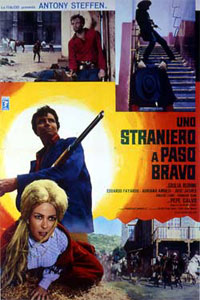A Stranger in Paso Bravo Review
< Los Pistoleros de Paso Bravo
1968
Dir: Salvatore Rosso
This film, the only spaghetti western directed by Salvatore Rosso, is often called the inspiration for Antonio Margheriti’s (better known) And God said to Cain. Some critics have even called Margheriti’s movie a remake. The similarities are too obvious to be ignored (they even concern the names of several central characters), but some story elements are decidedly different and I would say both films keep their own quite well. You can read my review of And God said to Cain here.
In the opening minutes, a man called Gary Hamilton (Anthony Steffen) seems to appear out of nothing in the middle of desert, unarmed and without a horse. Luckily he meets Pepe Calvo, a man who runs a department store on wheels, selling everything a man can possibly need in such an arid environment, including a mule ... for one hundred dollars (despite Steffen’s protests that such an animal is only worth fifteen!). When the stranger arrives in the town of Paso Bravo, his mule is shot during a crossfire, by men who work for a certain Acombar, but they offer Steffen fifteen dollars in compensation for his mule, the normal price such an animal (but Steffen utters that he has paid One hundred dollars for it!). Both Calvo and the mule are of course nice references to A Fistful of Dollars, and there’s also a saloon girl who sings (in Italian and with a smoker’s voice) a melancholic song you would expect in a Parisian bar in the Latin Quarter rather than a saloon: Se ne va la mia vita come fosse un fiume (My life passes as if it were a stream). She has a black clad boyfriend who is fast with the gun and seeks trouble with everybody who makes eyes at his girl (every man in town). That’s all very nice, and makes up – to some extent - for some sloppy story-telling during the first half of the movie. We’re not even told who Steffen is and why on earth he’s going to Paso Bravo. It’s only when he’s visiting the graves of his wife and daughter, that we begin to understand he is a classic avenger. Allegedly his loved ones died tragically in a fire while he was drunk, but Steffen presumes they were murdered. He manages to retrace the guys who ignited the fire, a trio called the Santamaria brothers, who tell him they were working for no other than Acombar (Fajardo) at the time. To get even, he teams up, in true Magnificent Seven style, with the sheriff and several other friends to attack the ranch of the local tyrant.
The film’s shortcomings are obvious. We are not told why Steffen has spent seven years in jail, nor why Fajardo (or any body else) ever wanted to kill Steffen’s wife and kid in the first place. There are some continuity problems too: the Spanish (Almeria desert) and Italian (Elios studios and Lazio hills) scenes don’t really harmonize, and especially the part with the Santamaria brothers feels detached from the rest of the movie (despite being essential to the plot!). But the film is saved by some witty dialogue, colourful characters and good performances. Steffen is his usual self, his one facial expression ironed the night before, but in one scene he tumbles of a stagecoach, rolls over and shoots no less than six men without flinching. Amazing! But the film very much belongs to Eduardo Fajardo, who is sensational as the local tyrant Acombar. This probably is his best performance, even outdoing his impersonation of the red KKK leader in Django. I especially loved the scene in which he tells his men he likes to see Steffen’s head on a pole. Bring me the Head of Anthony Steffen – it would’ve have been quite a title. There’s also a couple of hired killers, working for Acombar, who are having funny conversations all the time, and who reminded me of the couple of homosexual killers in the 007 movie Diamonds are forever.
Both Paso Bravo and Cain were made with a relatively small budget, and accordingly both look cheap. But Margheriti made more of the rather basic locations, especially the western town, and some story elements, like the parts with Fajardo’s son and the Santamaria brothers, are better integrated into the movie. Moreover he had the brilliant idea to set his movie largely at night and during a thunderstorm, so he could suggest (with a little dust and a lot of sound effects) what he wasn’t able to show. And of course he had Kinski instead of Steffen. But Rosso and his film score some points too. Slightly sluggish (and looking very cheap) during the first half, the tension is well built up in the second, leading to a memorable finale, with the famous Villa Mussolini (used more often in spaghetti westerns) serving as Acombar’s ranch. The scene with Fajardo being roasted in the fire (echoing the way Steffen’s relatives died), is more intense and effective (and far less protracted) than the similar fiery scene in Cain. Where Margheriti tried to squeeze every drop out of the situation (and ruining it instead), Rosso is content with a few hints, creating one of the best alternative death scenes in the genre.
--By Scherpschutter




